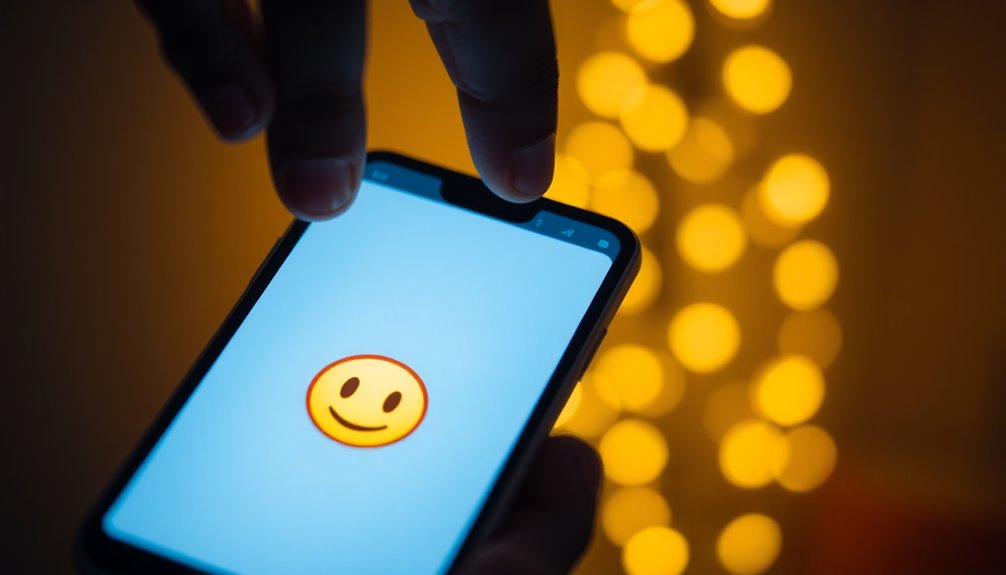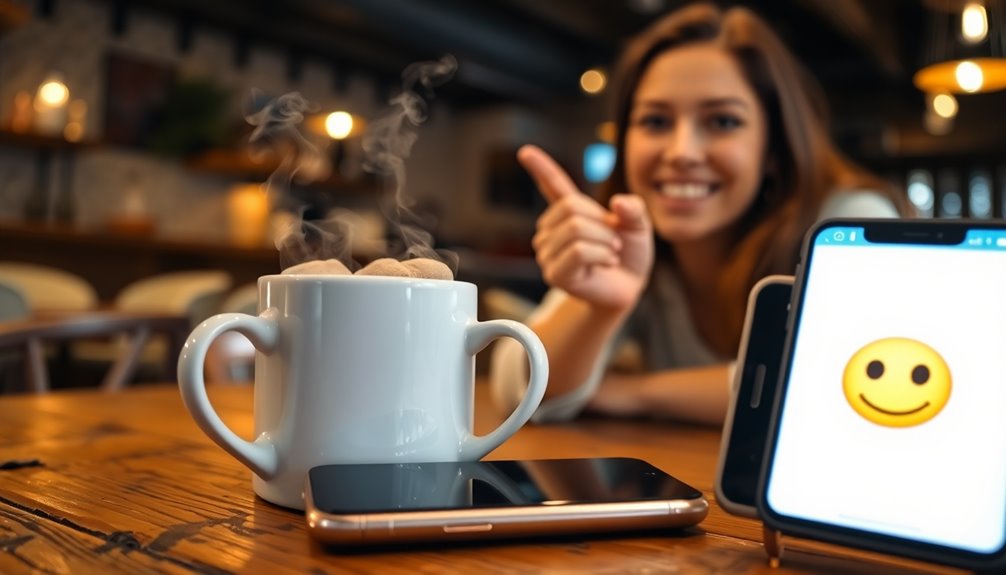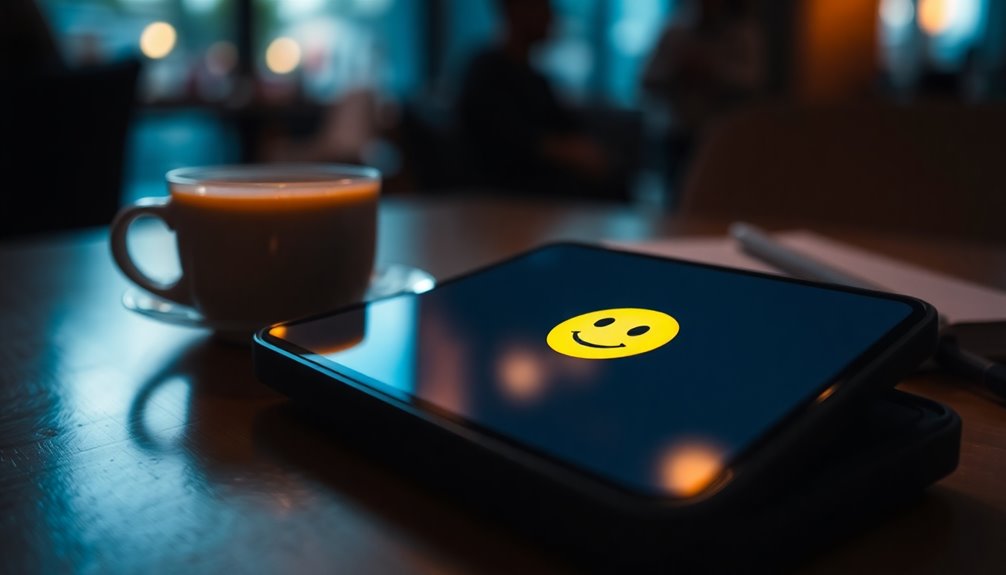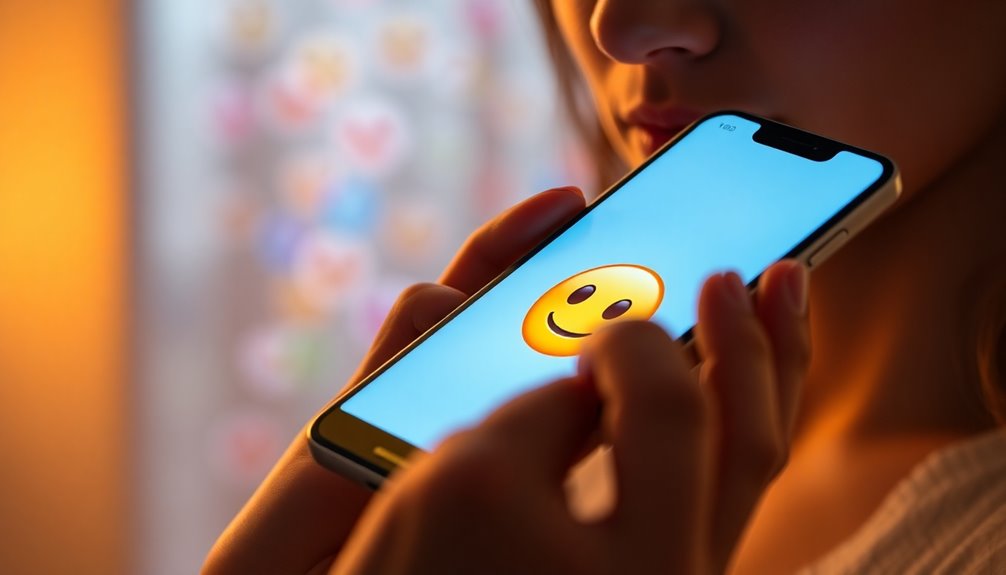Using the 😌 emoji can dramatically shift how she perceives your intentions and emotions in text conversations. This emoji conveys warmth and positivity, making your messages feel more engaging and relatable. It enhances emotional clarity, allowing her to interpret your feelings better. Given that women often prefer face-related emojis, this simple trick aligns well with their communication style, helping to foster connection. Remember to place it at the end of your messages for maximum impact. If you want to uncover more strategies to enhance your digital interactions, there's a lot more to explore!
Key Takeaways
- Use the 😌 emoji at the end of messages to convey warmth and relaxation, enhancing emotional tone and making interactions feel more personal.
- Incorporate the 😌 emoji in professional conversations to express approachability, fostering a positive perception in workplace communications.
- Utilize the 😌 emoji in casual chats to clarify your intent and reduce misunderstandings, thus improving your connection with her.
- Experiment with the 😌 emoji during conversations to gauge her reactions, helping you understand her emotional responses and preferences.
- Be mindful of cultural differences; ensure the 😌 emoji resonates positively with her background to avoid misinterpretation.
The Power of Emojis

Emojis transform the way we communicate, adding a layer of emotional depth that plain text often lacks. When you use emojis, you enrich your messages, making them more relatable and expressive. They serve as visual cues that clarify your tone, bridging the gap between digital and face-to-face interactions. By incorporating emojis, you can convey emotions like happiness or empathy more effectively, ensuring your message is accurately received.
Using emojis can also save you time. Instead of crafting lengthy explanations, a simple emoji can summarize your intent. Plus, emojis draw attention in a crowded space of text, making your messages more engaging. Whether you're texting a friend or communicating in a work setting, emojis can make your interactions feel warmer and more approachable. Emojis also help in the recognition and understanding of emotions, enhancing emotional awareness in your communications.
However, be mindful of cultural differences in emoji meanings, as misunderstandings can arise. The right emoji can enhance your message, but it should complement the text rather than replace it. By harnessing the power of emojis, you create clearer, more impactful communications that resonate with your audience and strengthen your connections.
Understanding Emotional Intelligence

Emotional intelligence is crucial for navigating both personal and professional relationships effectively. It starts with self-awareness, where you recognize and understand your own emotions and reactions. This awareness helps you see how your feelings impact your life experiences and those around you. By identifying your likes, dislikes, and establishing life goals, you lay the groundwork for better decision-making.
Next is self-regulation. This involves controlling or redirecting disruptive impulses and managing negative emotions. When you think before acting, you maintain respect for others and hold yourself accountable for mistakes. This control is key in fostering healthy interactions.
Motivation is another essential aspect. It's about having a passion for your work that goes beyond money or status. When you apply persistence and energy to your activities, you're more likely to seize opportunities and act assertively, leading to a positive outlook.
Lastly, social awareness and skills matter. This means understanding the emotional makeup of others and responding empathetically. By honing your communication and conflict resolution skills, you enhance your relationships, making you more appealing to those around you. Developing strong communication skills can significantly improve your interactions and relationships with others.
Attachment Styles Matter

Understanding attachment styles is vital for building and maintaining healthy relationships. Your attachment style influences how you connect with others, affecting intimacy, trust, and communication. If you have a secure attachment, you likely feel comfortable with closeness and balance between dependence and independence. This allows you to build deeper emotional connections, fostering healthier, more satisfying relationships. Research indicates that secure attachment positively correlates with relationship satisfaction, making it crucial for long-term success. Additionally, developing a growth mindset can further enhance your ability to navigate relationship challenges. Engaging in trust-building activities can also reinforce the foundation of your relationships. Moreover, understanding the impact of pet therapy can enrich emotional well-being, providing companionship and reducing feelings of isolation.
On the other hand, if you identify with anxious (preoccupied) attachment, you might crave intimacy but also feel overly dependent on your partner. This can lead to anxiety and a fear of abandonment, which may overwhelm your partner with constant reassurance-seeking.
If you lean towards avoidant (dismissive) attachment, you may prioritize independence and emotional distance, sometimes coming off as detached. This can hinder your ability to engage deeply in relationships.
Lastly, if you have a fearful (disorganized) attachment style, you might experience a push-pull dynamic, desiring closeness yet fearing vulnerability. This inconsistency can create significant challenges in trusting your partner.
Recognizing your attachment style helps you understand your relationship dynamics better and allows you to cultivate healthier connections.
Gender Differences in Usage

In the realm of digital communication, gender differences in emoji usage reveal fascinating insights into how individuals express themselves. You'll notice that women tend to use emojis and emoticons more frequently, often employing twice as many as men. Young adults, especially females, embrace emojis more than older generations, reflecting a shift in communication styles. Research indicates that emotional expression is critical for emotional regulation, which can also influence how emojis are interpreted in messages.
While males might choose a greater variety of emojis in some studies, this contrasts with the overall trend. Women typically favor face-related emojis, showcasing their social orientation, while men lean towards heart-related emojis, emphasizing positive emotions. The "face with tears of joy" emoji is popular among both genders, but preferences diverge with women often opting for the "loudly crying face," while men prefer the "folded hands" emoji.
Functionally, females use emojis to illustrate emotions and express support, whereas males employ them to emphasize messages and convey sarcasm. This difference highlights how societal stereotypes shape emoji use, leading to varied interpretations based on the sender's gender. Interestingly, both genders use emojis to enhance message meaning, which underscores their role in bridging communication gaps. Understanding these nuances helps you communicate effectively and connects you on a deeper level.
Contextual Emoji Communication

Emoji usage can be a tricky terrain to navigate, especially since their meanings shift dramatically depending on context. The same emoji can convey different feelings or intentions based on the conversation or relationship you share. For instance, a simple smiley 😊 may express friendliness in one situation, but it could come off as flirty in another.
Cultural differences also play a significant role in how emojis are interpreted. What seems playful to you might be considered inappropriate in another culture. This highlights the importance of considering the recipient's background when sending emojis. Contextual clues within your text can help clarify your intent, so don't rely solely on the emoji itself.
Moreover, emojis act as paralanguage, enhancing your message's meaning without standing alone. They can indicate tone, mood, or urgency, especially in virtual communication, where misunderstandings are easy. For example, using the thumbs-up emoji 👍 can signal quick approval, while a heart ❤️ might convey deeper emotional support. Recent research shows that emojis are increasingly used as direct communication tools on social media, reflecting their role in human interaction.
Ultimately, being mindful of the context and your relationship with the recipient can significantly enhance the effectiveness of your emoji communication.
The Psychology Behind Emojis

The psychology behind emojis reveals how these small icons impact our emotions and communication. When you use emojis, they're not just cute additions; they actually activate the same brain regions as real human faces. This means a simple smiley face can influence your mood and even your facial expressions, making your messages feel more connected and engaging. Emojis activate similar brain regions as real human faces.
Emojis serve as nonverbal cues, much like body language in face-to-face conversations. They help clarify your intentions and express subtle emotions, which can be especially useful in online interactions. Depending on your personality traits, you might find that using positive emojis aligns with agreeableness and extraversion, while negative emojis could reflect emotional struggles. Additionally, using emojis can enhance your ability to maintain emotional alignment in digital communication, similar to how positive affirmations can foster healthy interactions. Self-care practices can also improve your overall emotional health, which may influence your emoji usage.
Moreover, emojis can disambiguate unclear messages, helping others understand whether you're joking or being serious. The intensity of your emoji use often varies by context; you're likely more expressive with close friends than in professional settings. Ultimately, the psychology of emojis underscores their powerful role in how you convey feelings and connect with others, making them a tool worth mastering in your communication arsenal.
Building Connection Through Emojis

Understanding the psychology behind emojis sets the stage for recognizing their role in building connections. Emojis enhance emotional expression, providing visual cues that help you convey feelings like happiness, sadness, or love more effectively. When you use emojis in your messages, they not only clarify your emotional tone but also make you seem warmer and more approachable. This fosters a sense of empathy, allowing you to better understand and connect with her emotional experiences. Additionally, the use of emojis can enhance communication clarity in ways similar to how flight training enhances pilot skills.
Moreover, emojis bridge the gap in digital communication by adding emotional cues often missing from text alone. They reduce misunderstandings and enhance clarity, making your intentions clearer. A well-placed emoji can transform a simple message into a friendly interaction, effectively deepening your connection. The standardization of emojis has further contributed to their widespread use, allowing for consistent emotional expression across various platforms.
In professional contexts, emojis play a crucial role too. They express nuances that words may fail to capture, helping you build rapport with colleagues and clients. By using emojis appropriately, you signal respect and care for relationships, which is vital for teamwork. Overall, integrating emojis into your communication can strengthen connections, making interactions more meaningful and supportive.
Practical Tips for Emoji Use

When diving into emoji use, remember that these small images can significantly enhance your messages if used correctly. First, avoid replacing words with emojis; they should complement your text, not substitute it. Screen readers only interpret the alt text of emojis, which could alter your intended message. Stick to using one clear emoji per text, and only when it adds value. Too many emojis can clutter your message and confuse the recipient. Additionally, using emojis can add a layer of humor and relatability to your communication, much like clever literary quotes. Recognizing signs of stagnation in communication can help you use emojis more effectively.
Next, pay attention to placement and context. Always place emojis at the end of sentences to maintain clarity, and steer clear of inserting them within words. Using emojis after punctuation helps keep your message organized. Additionally, research shows that 92% of online users use emojis in their communication, highlighting their prevalence and importance.
Lastly, consider accessibility and cultural differences. Neutral skin tones, like yellow, provide better contrast across backgrounds. Be aware that some emojis may carry different meanings in various cultures, so choose wisely to avoid misunderstandings. Keep your audience's familiarity with emojis in mind to ensure your messages resonate. By following these practical tips, you'll effectively use emojis to create engaging and clear communication that enhances your connection.
Analyzing Your Emoji Strategy

Analyzing your emoji strategy is key to maximizing their impact in your communications. Emojis can express emotional tone, making your messages feel warmer and more engaging, especially in text-heavy environments. However, remember that different emojis can convey varying meanings. For instance, the slightly smiling face 🙂 can be interpreted as sweet or even patronizing, so choose wisely.
Consider your audience and the cultural context. Some cultures favor positive emojis, while others might lean towards negative ones. This awareness can prevent misunderstandings. Also, using emojis can boost engagement rates significantly—emails with emojis in the subject line see a 56% higher open rate, while social media posts often garner more likes and shares. Clear communication is essential, as ambiguous emojis can lead to misinterpretations and misunderstandings. Keeping your content relevant and authoritative is crucial for enhancing user engagement. Additionally, employing a well-structured content strategy can help ensure that your emoji usage aligns with your overall messaging goals.
Keep your emoji usage strategic and relatable. Test different approaches through A/B testing to find what resonates best with your audience. Lastly, be mindful of the hidden meanings that certain emojis may carry in different contexts. A well-thought-out emoji strategy not only enhances clarity but also adds to your credibility, making your communications more effective and relatable.
Future of Emoji Communication

Embracing the future of emoji communication means recognizing their evolving role in digital interactions. As you navigate the workplace, you'll find that 70% of U.S. emoji users are already incorporating them into their professional conversations. This trend is only growing, with 53% increasing their emoji use recently. They help you convey emotions and intent more clearly, especially in hybrid environments where nuances matter. Additionally, emoji usage is linked to improved emotional connections among colleagues.
Emoji add warmth and personality to your messages, enhancing connections and making communication feel more genuine. They serve as a universal language, breaking down cultural barriers and fostering relationships among diverse teams. Plus, custom emoji can infuse your company culture with a sense of playfulness and connection.
Looking ahead, expect ongoing updates to the Unicode standard, reflecting societal changes and the need for inclusivity. Future emojis will likely encompass a broader range of expressions, enabling you to communicate complex feelings or actions with mere symbols. This evolution will enhance emotional expression and connectivity, making your digital interactions even richer. With advancements like purchasing items via emoji and visiting emoji-based URLs, the possibilities are endless. Embrace this transformation, and watch how it enhances your communication.
Frequently Asked Questions
Can Emojis Improve My Chances of Dating Success?
Yes, using emojis can definitely improve your chances of dating success. They add personality to your messages and help convey emotions more clearly than plain text. Emojis create a warm and inviting atmosphere, making it easier for you to connect with potential partners. By incorporating them into your communication, you not only enhance your interactions but also increase your likelihood of establishing intimacy and rapport, leading to more dates and deeper connections.
What Are the Most Effective Emojis for Flirting?
When flirting, using the right emojis can really enhance your message. Try the 😉 wink for playful banter, or the 😍 heart eyes to show genuine admiration. The 😏 smirking face adds a confident edge, while the 😈 mischievous devil can spice things up. Don't forget the 🙃 upside-down smiley for a light-hearted touch. Mixing these emojis can create an inviting atmosphere and signal your interest in a fun, engaging way.
How Do Emojis Affect Professional Communication?
Emojis can significantly impact professional communication by adding a personal touch and clarifying your intentions. When you use them thoughtfully, they make your messages more engaging and relatable. However, you've gotta be cautious; misinterpretations can arise, especially with diverse audiences. It's essential to know your context and audience. By mirroring your recipient's style, you can foster better connections while maintaining professionalism and ensuring your message hits the mark.
Are There Cultural Differences in Emoji Interpretation?
Yes, there are definitely cultural differences in emoji interpretation. You might use the "thumbs-up" emoji to express approval, but in some cultures, it could be offensive. Similarly, the "folded hands" emoji carries various meanings, from gratitude to prayer, depending on the context. Understanding these nuances is crucial for effective communication. Be aware of how your audience might interpret emojis differently based on their cultural background to avoid misunderstandings.
Can Overusing Emojis Be Detrimental to Communication?
Yes, overusing emojis can be detrimental to communication. When you rely too heavily on emojis, you risk losing the nuances of verbal expression. This can make your conversations feel impersonal or cold. Plus, it might hinder your ability to convey genuine emotions face-to-face. By masking feelings with emojis, you could create misunderstandings and prevent authentic connections. Striking a balance is key; sometimes, words carry more weight than a smiley face ever could.
Conclusion
Incorporating emojis into your communication can truly transform how she perceives you. By mastering emotional intelligence and understanding her attachment style, you can use emojis to build a stronger connection. Remember to consider context and gender differences in usage. With a thoughtful emoji strategy, you’ll express your feelings more effectively and enhance your interactions. Embrace this powerful tool, and watch your relationship flourish as you connect on a deeper level. Don’t underestimate the impact of a simple emoji! Additionally, using emojis can serve as a playful way to gauge her interest and respond to her cues, making your communication feel more dynamic and engaging. For example, if you share a cute or funny emoji in response to her messages, it can lighten the mood and open the door for deeper conversations. In fact, one trick to ask her out is to include a cheerful emoji in your invitation, as it can convey your excitement and make the proposition feel more inviting. By leveraging this simple yet effective approach, you can create memorable moments that might just lead to the next step in your relationship.









